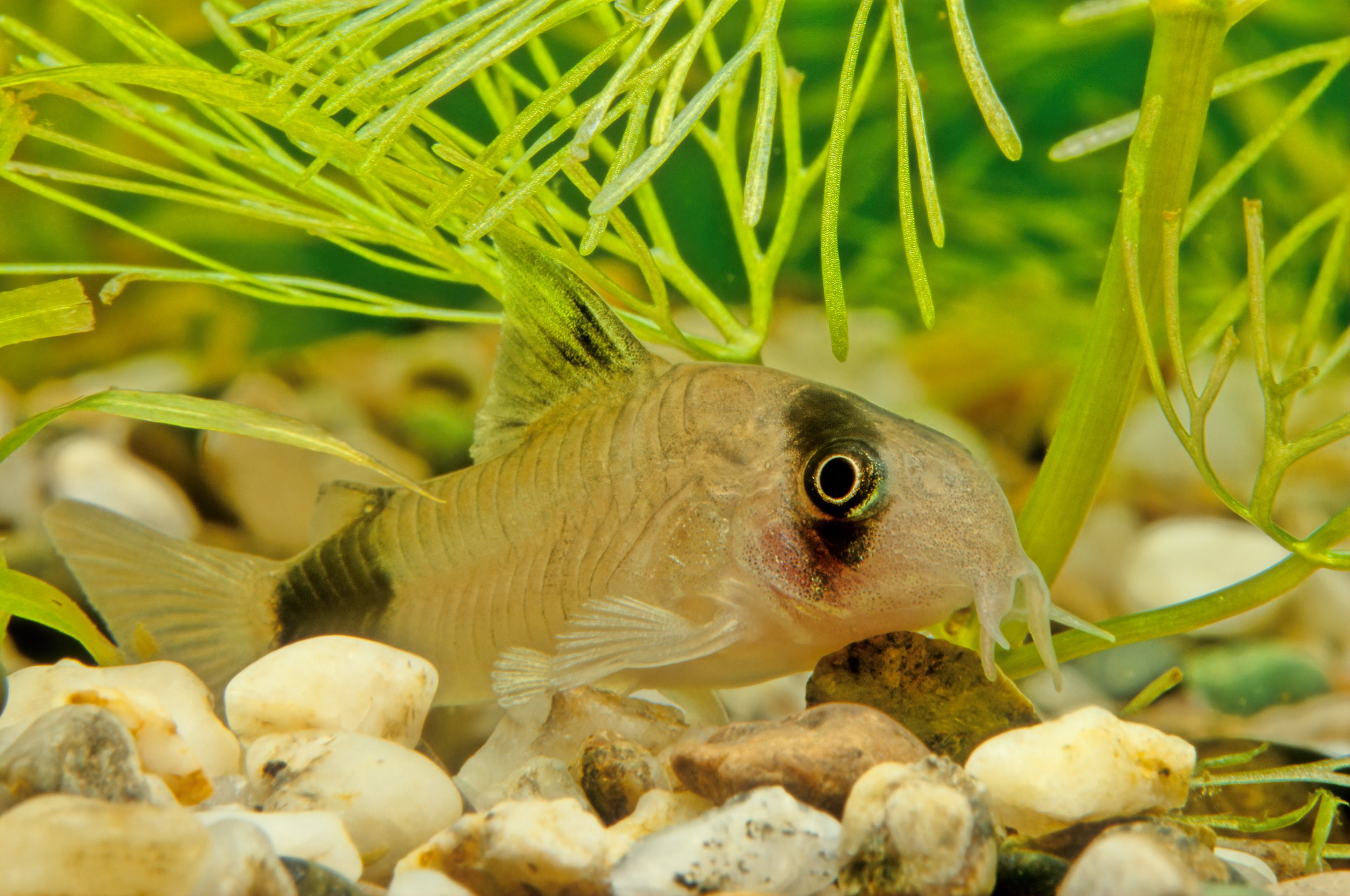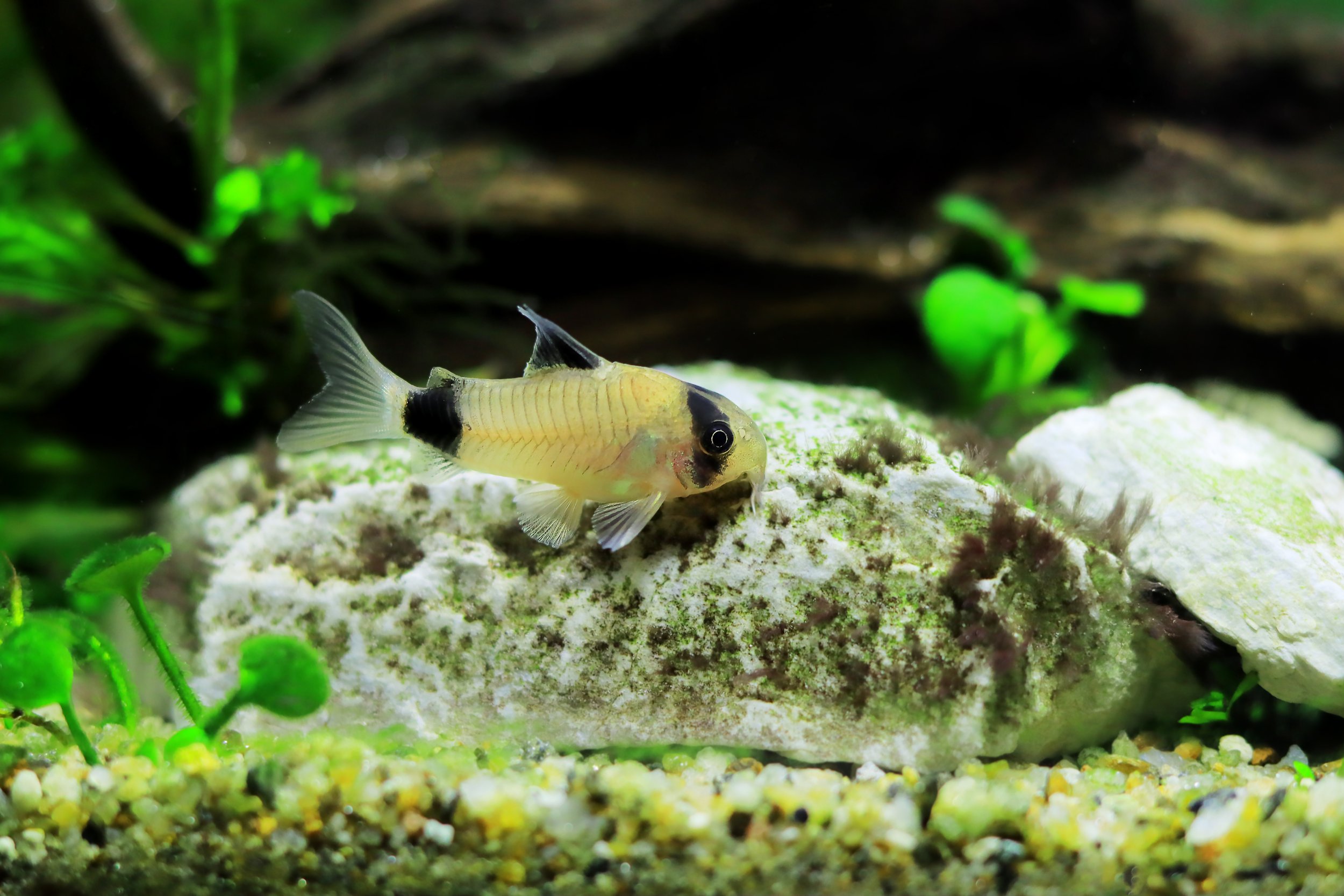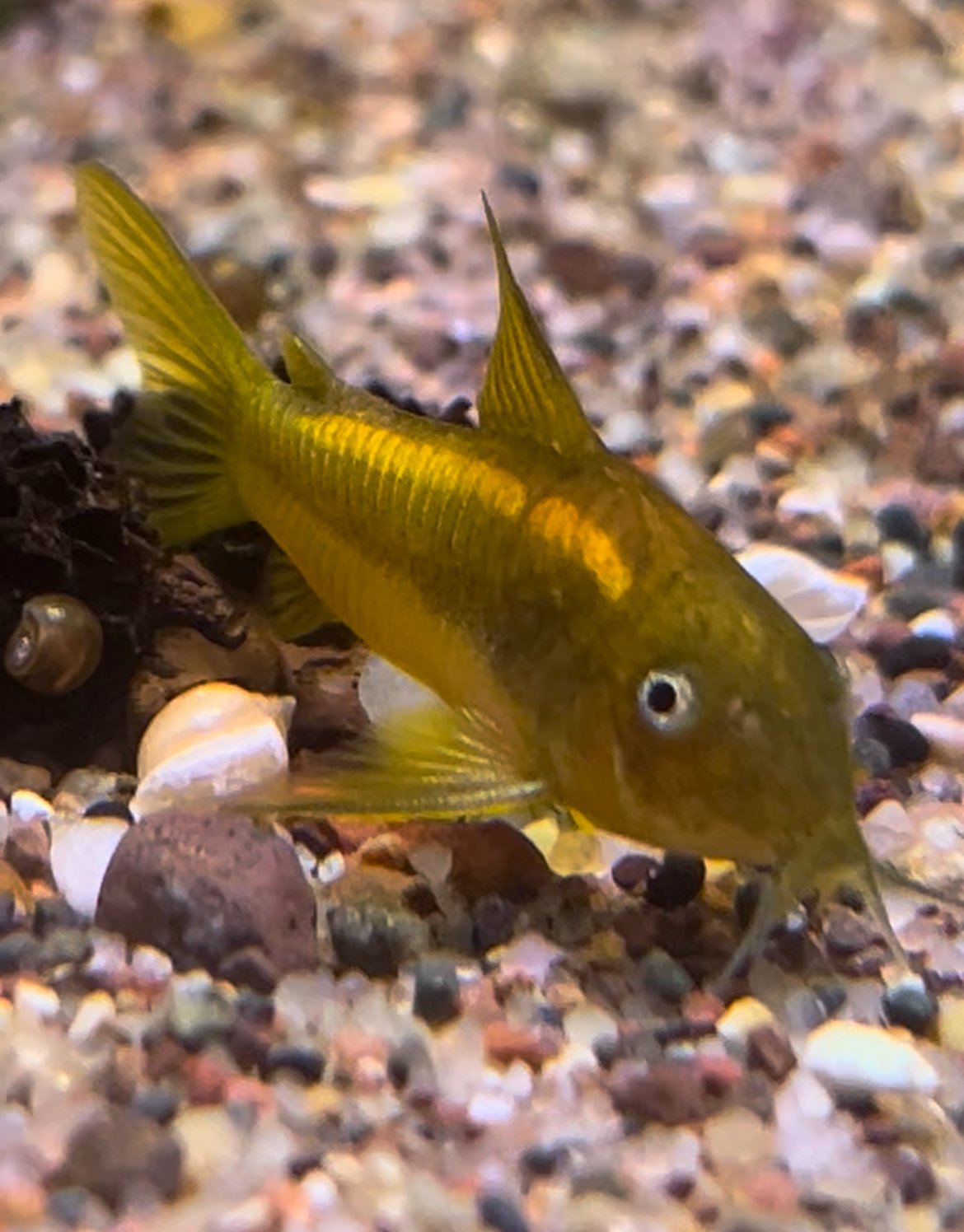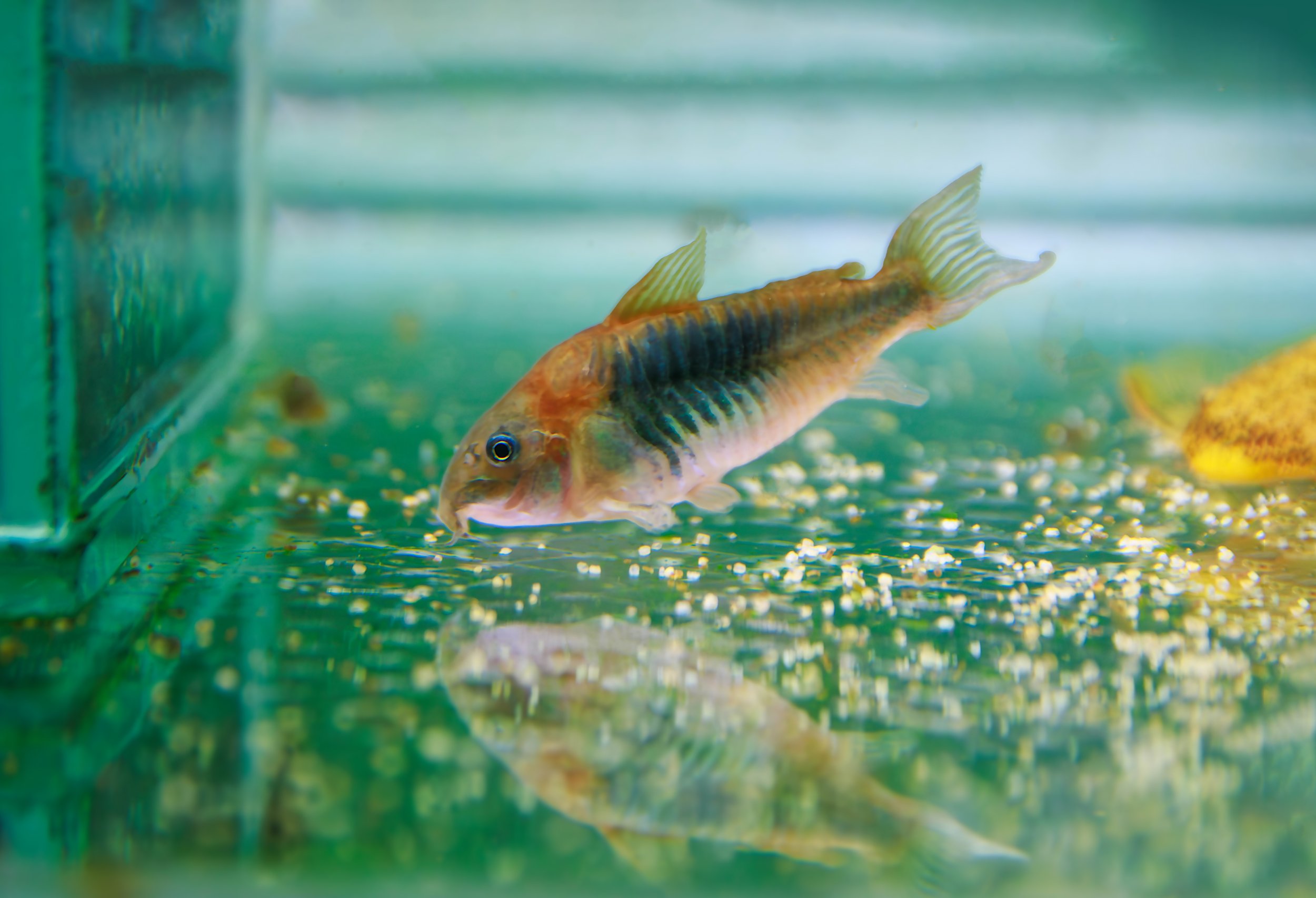 Image 1 of 3
Image 1 of 3

 Image 2 of 3
Image 2 of 3

 Image 3 of 3
Image 3 of 3




Panda Cory-S
The Panda Cory, scientifically known as Corydoras panda, is one of the most popular and beloved species of Corydoras catfish in the aquarium hobby. Native to the cool, slow-moving waters of the tributaries in the Ucayali River system in Peru, this small and peaceful catfish is well-loved for its striking black-and-white coloration and lively, social behavior. Panda Corys are an excellent choice for community tanks and are suitable for both beginner and experienced aquarists.
Physical Description:
The Panda Cory is easily recognized by its distinctive black-and-white “panda-like” markings, which give it its common name. Its body is a creamy white or pale pink with prominent black markings around the eyes (like a panda), on the dorsal fin, and at the base of the tail. This bold coloration makes it a beautiful and eye-catching addition to any aquarium. Panda Corys are small, typically reaching about 1.5 to 2 inches (4 to 5 centimeters) in length, making them ideal for smaller tanks and community setups.
Aquarium Care:
Panda Corys thrive in well-planted tanks with soft, sandy substrates, as they spend much of their time foraging along the bottom. A soft substrate is essential to protect their sensitive barbels, which they use to search for food. Providing plenty of hiding spots, such as driftwood, rocks, and plants, will help them feel secure. Panda Corys are highly social fish and should be kept in groups of at least six to encourage natural schooling behavior and reduce stress.
Water Parameters:
The natural habitat of Panda Corys includes cool, oxygen-rich waters, so maintaining a suitable environment is important for their health. They prefer slightly acidic to neutral water with a pH range of 6.0 to 7.5 and temperatures between 68 to 77°F (20 to 25°C). Regular water changes and good filtration are essential to keep the water clean, as Corydoras species can be sensitive to poor water quality.
Feeding:
Feeding Panda Corys is easy, as they are omnivorous and will accept a variety of foods. They do well on a diet of high-quality sinking pellets or wafers, along with occasional live or frozen foods such as bloodworms, brine shrimp, and daphnia. These small bottom-dwellers will also scavenge for uneaten food on the substrate, but it’s important to provide them with dedicated food to ensure they receive proper nutrition.
Breeding:
Breeding Panda Corys in captivity is possible and can be quite rewarding. They are egg-layers, and spawning can often be triggered by performing a large water change with slightly cooler water, mimicking the rainy season in their natural habitat. During breeding, the female will lay her eggs on flat surfaces, such as leaves, glass, or decorations. The eggs hatch within about 3 to 5 days, and the fry can be fed on infusoria or specially prepared fry food before transitioning to baby brine shrimp as they grow.
Overall:
The Panda Cory (Corydoras panda) is a charming, hardy, and visually appealing catfish that makes an excellent addition to community aquariums. Their unique appearance, peaceful nature, and active, social behavior make them a favorite among aquarists of all levels. With proper care, a suitable environment, and attention to their specific needs, Panda Corys will thrive and bring life, color, and personality to any freshwater setup.
The Panda Cory, scientifically known as Corydoras panda, is one of the most popular and beloved species of Corydoras catfish in the aquarium hobby. Native to the cool, slow-moving waters of the tributaries in the Ucayali River system in Peru, this small and peaceful catfish is well-loved for its striking black-and-white coloration and lively, social behavior. Panda Corys are an excellent choice for community tanks and are suitable for both beginner and experienced aquarists.
Physical Description:
The Panda Cory is easily recognized by its distinctive black-and-white “panda-like” markings, which give it its common name. Its body is a creamy white or pale pink with prominent black markings around the eyes (like a panda), on the dorsal fin, and at the base of the tail. This bold coloration makes it a beautiful and eye-catching addition to any aquarium. Panda Corys are small, typically reaching about 1.5 to 2 inches (4 to 5 centimeters) in length, making them ideal for smaller tanks and community setups.
Aquarium Care:
Panda Corys thrive in well-planted tanks with soft, sandy substrates, as they spend much of their time foraging along the bottom. A soft substrate is essential to protect their sensitive barbels, which they use to search for food. Providing plenty of hiding spots, such as driftwood, rocks, and plants, will help them feel secure. Panda Corys are highly social fish and should be kept in groups of at least six to encourage natural schooling behavior and reduce stress.
Water Parameters:
The natural habitat of Panda Corys includes cool, oxygen-rich waters, so maintaining a suitable environment is important for their health. They prefer slightly acidic to neutral water with a pH range of 6.0 to 7.5 and temperatures between 68 to 77°F (20 to 25°C). Regular water changes and good filtration are essential to keep the water clean, as Corydoras species can be sensitive to poor water quality.
Feeding:
Feeding Panda Corys is easy, as they are omnivorous and will accept a variety of foods. They do well on a diet of high-quality sinking pellets or wafers, along with occasional live or frozen foods such as bloodworms, brine shrimp, and daphnia. These small bottom-dwellers will also scavenge for uneaten food on the substrate, but it’s important to provide them with dedicated food to ensure they receive proper nutrition.
Breeding:
Breeding Panda Corys in captivity is possible and can be quite rewarding. They are egg-layers, and spawning can often be triggered by performing a large water change with slightly cooler water, mimicking the rainy season in their natural habitat. During breeding, the female will lay her eggs on flat surfaces, such as leaves, glass, or decorations. The eggs hatch within about 3 to 5 days, and the fry can be fed on infusoria or specially prepared fry food before transitioning to baby brine shrimp as they grow.
Overall:
The Panda Cory (Corydoras panda) is a charming, hardy, and visually appealing catfish that makes an excellent addition to community aquariums. Their unique appearance, peaceful nature, and active, social behavior make them a favorite among aquarists of all levels. With proper care, a suitable environment, and attention to their specific needs, Panda Corys will thrive and bring life, color, and personality to any freshwater setup.
The Panda Cory, scientifically known as Corydoras panda, is one of the most popular and beloved species of Corydoras catfish in the aquarium hobby. Native to the cool, slow-moving waters of the tributaries in the Ucayali River system in Peru, this small and peaceful catfish is well-loved for its striking black-and-white coloration and lively, social behavior. Panda Corys are an excellent choice for community tanks and are suitable for both beginner and experienced aquarists.
Physical Description:
The Panda Cory is easily recognized by its distinctive black-and-white “panda-like” markings, which give it its common name. Its body is a creamy white or pale pink with prominent black markings around the eyes (like a panda), on the dorsal fin, and at the base of the tail. This bold coloration makes it a beautiful and eye-catching addition to any aquarium. Panda Corys are small, typically reaching about 1.5 to 2 inches (4 to 5 centimeters) in length, making them ideal for smaller tanks and community setups.
Aquarium Care:
Panda Corys thrive in well-planted tanks with soft, sandy substrates, as they spend much of their time foraging along the bottom. A soft substrate is essential to protect their sensitive barbels, which they use to search for food. Providing plenty of hiding spots, such as driftwood, rocks, and plants, will help them feel secure. Panda Corys are highly social fish and should be kept in groups of at least six to encourage natural schooling behavior and reduce stress.
Water Parameters:
The natural habitat of Panda Corys includes cool, oxygen-rich waters, so maintaining a suitable environment is important for their health. They prefer slightly acidic to neutral water with a pH range of 6.0 to 7.5 and temperatures between 68 to 77°F (20 to 25°C). Regular water changes and good filtration are essential to keep the water clean, as Corydoras species can be sensitive to poor water quality.
Feeding:
Feeding Panda Corys is easy, as they are omnivorous and will accept a variety of foods. They do well on a diet of high-quality sinking pellets or wafers, along with occasional live or frozen foods such as bloodworms, brine shrimp, and daphnia. These small bottom-dwellers will also scavenge for uneaten food on the substrate, but it’s important to provide them with dedicated food to ensure they receive proper nutrition.
Breeding:
Breeding Panda Corys in captivity is possible and can be quite rewarding. They are egg-layers, and spawning can often be triggered by performing a large water change with slightly cooler water, mimicking the rainy season in their natural habitat. During breeding, the female will lay her eggs on flat surfaces, such as leaves, glass, or decorations. The eggs hatch within about 3 to 5 days, and the fry can be fed on infusoria or specially prepared fry food before transitioning to baby brine shrimp as they grow.
Overall:
The Panda Cory (Corydoras panda) is a charming, hardy, and visually appealing catfish that makes an excellent addition to community aquariums. Their unique appearance, peaceful nature, and active, social behavior make them a favorite among aquarists of all levels. With proper care, a suitable environment, and attention to their specific needs, Panda Corys will thrive and bring life, color, and personality to any freshwater setup.






